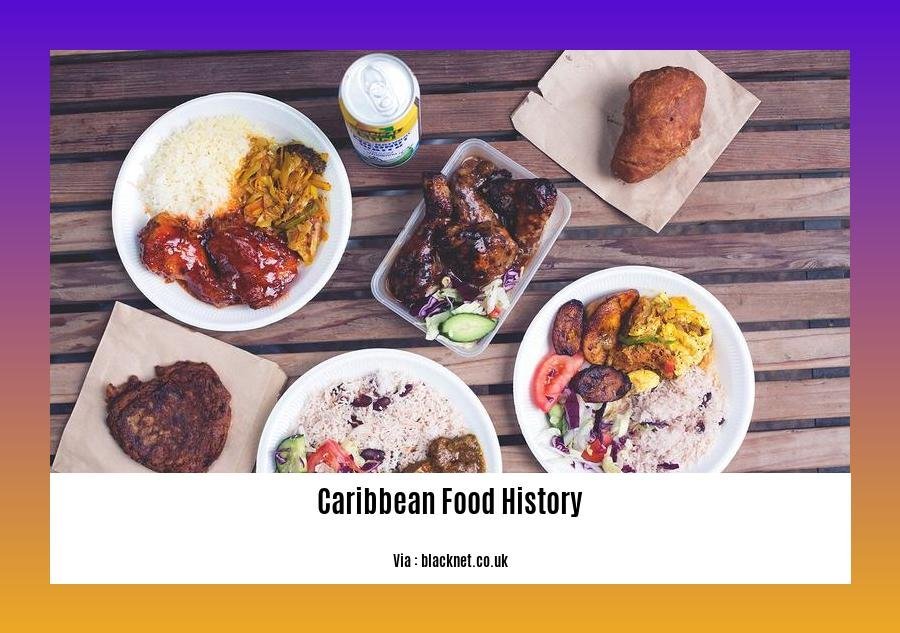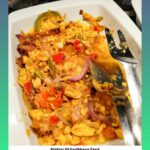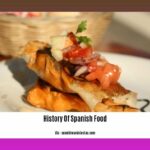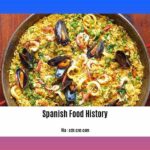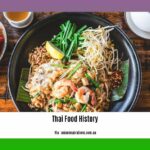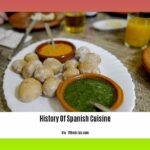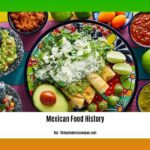Unveiling the Culinary Treasures of the Caribbean: A Historical Journey Through Caribbean Food History. Embark on a tantalizing voyage through the culinary heritage of the Caribbean, where a vibrant tapestry of flavors and aromas unfolds, reflecting the region’s rich cultural fusion. From the fiery accents of Scotch bonnet peppers to the aromatic embrace of jerk seasoning, let’s delve into the stories and traditions that have shaped this delectable cuisine, celebrating its unique identity and global influence.
Key Takeaways:
Caribbean cuisine is a captivating fusion of indigenous, African, Spanish, French, British, Dutch, and East Indian influences.
Indigenous Caribbean people utilized available ingredients like cassava, yams, and plantains to create a unique cuisine.
African slaves introduced bold and vibrant flavors to Caribbean cooking through their culinary traditions.
European colonization brought new ingredients like coconut, chickpeas, cilantro, eggplant, onion, and garlic to the region.
Caribbean cuisine has had a significant impact on global cuisine, especially in the United States and the United Kingdom, due to Caribbean immigration.
Popular Caribbean dishes include oxtail stew, curry chicken, rice and peas, ackee and saltfish, and jerk chicken.
Caribbean Food History: A Culinary Odyssey
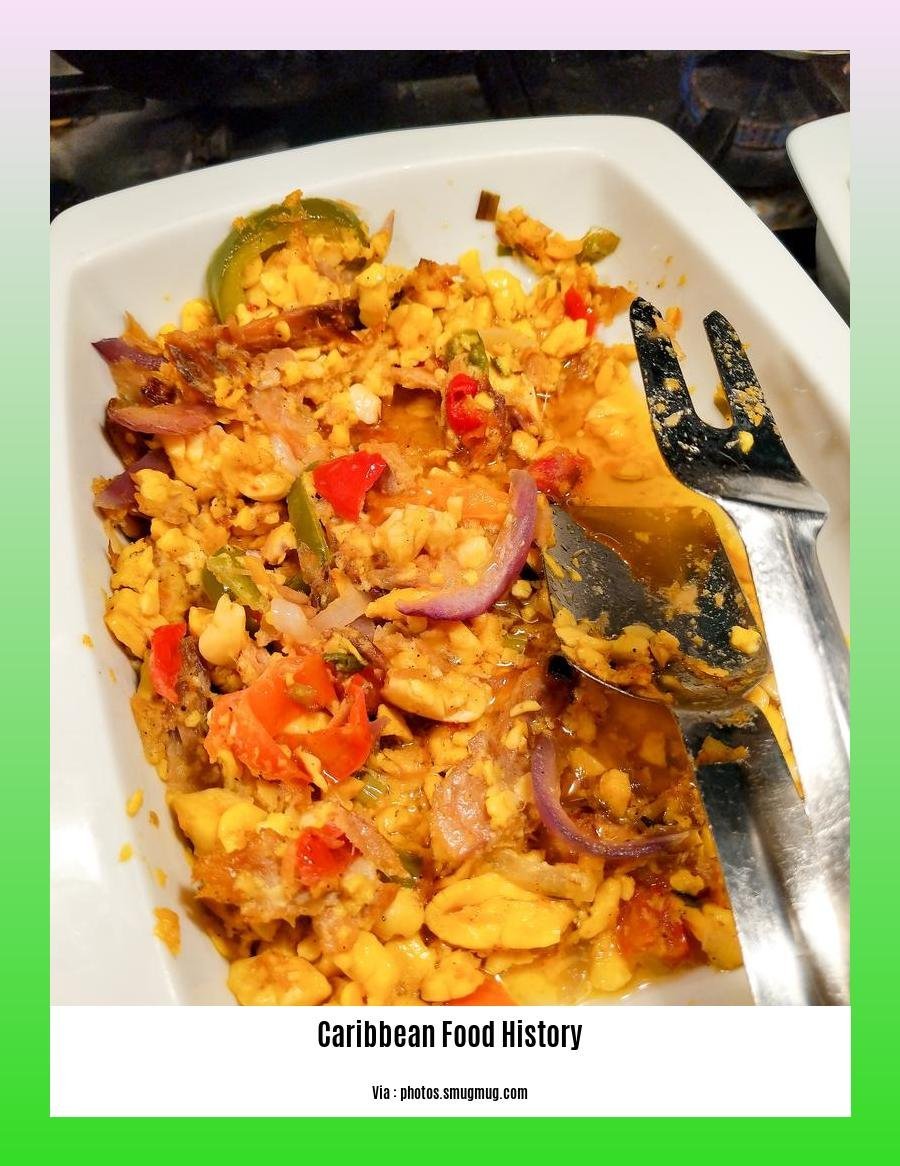
Picture a tantalizing blend of flavors, a symphony of spices, and a vibrant tapestry of cultures. This is the essence of Caribbean cuisine, a culinary journey that has captivated taste buds worldwide.
Indigenous Roots and African Influence
The story begins with the indigenous people of the Caribbean, who crafted their unique cuisine using the ingredients that nature provided. Cassava, yams, and plantains were the cornerstones of their diet, accompanied by tropical fruits and the bounty of the sea.
With the arrival of African slaves, a new chapter in Caribbean culinary history unfolded. They brought with them their culinary traditions, infusing Caribbean cuisine with bold flavors and vibrant spices. The result was a harmonious blend of African and indigenous influences, creating the foundation for the diverse dishes we know today.
The European Influence
European colonization left an indelible mark on Caribbean cuisine. The Spanish, French, British, Dutch, and East Indians introduced a plethora of ingredients that would become integral to Caribbean cooking. Coconut, chickpeas, cilantro, eggplant, onion, and garlic were among the many ingredients that found their way into the Caribbean kitchen, adding layers of flavor and complexity.
A Culinary Legacy
Caribbean cuisine has not only shaped the culinary landscape of the region but has also left a lasting impact on global cuisine. Through the movement of Caribbean people around the world, particularly to the United States and the United Kingdom, Caribbean flavors and dishes have found a new home, influencing and enriching the cuisines of these countries.
Popular Caribbean Dishes
No exploration of Caribbean food history would be complete without mentioning some of the iconic dishes that have become synonymous with the region. Oxtail stew, a hearty and flavorful dish made with tender oxtails simmered in a rich sauce, is a beloved favorite.
Curry chicken, a legacy of the Indian influence, tantalizes taste buds with its aromatic blend of spices and tender chicken. Rice and peas, a comforting dish of rice cooked in coconut milk and served with stewed peas, is a staple in many Caribbean households.
Ackee and saltfish, a Jamaican national dish, combines the unique flavors of ackee, a fruit native to West Africa, and salted codfish, creating a savory and unforgettable dish.
And of course, no mention of Caribbean cuisine would be complete without jerk chicken. This spicy, smoky dish, made with chicken marinated in a fiery blend of herbs and spices, is a true testament to the vibrant flavors of the Caribbean.
Conclusion
The Caribbean food history is a vibrant tapestry woven with the threads of multiple cultures. It is a cuisine that celebrates the diversity of its people, their resilience, and their creativity. From the humble beginnings of indigenous cooking to the complex fusion of flavors that has emerged over centuries, Caribbean cuisine continues to captivate and inspire, leaving a lasting legacy on the global culinary stage.
Embark on a culinary journey through time and discover the fascinating asian food history, tracing the evolution of flavors and traditions that have shaped the world’s cuisine.
European Encounters: Examining the Exchange of Ingredients and Culinary Practices between the Caribbean and European powers
Ever since the Europeans set sail for the Caribbean, an exciting trade of flavors, ideas, and techniques sparked a culinary revolution that continues to delight palates today. This exchange transformed cuisines on both sides of the Atlantic.
Many ingredients that now define Caribbean cuisine were European imports. Take the humble onion, garlic, and cilantro, which added depth and complexity to local dishes. Tropical fruits like oranges, lemons, and limes lent a refreshing tang, while the introduction of animal meats (such as chicken, pork, and beef) expanded the culinary repertoire.
At the same time, European cuisines were transformed by the exotic ingredients they discovered in the Caribbean. Take the tomato, once a humble Caribbean staple, which became a beloved ingredient across Europe. Or consider the alluring potato, now a global comfort food. And let’s not forget chocolate, that magical elixir that conquered European hearts and taste buds.
The Caribbean, with its unique blend of cultures and flavors, stands as a testament to the power of culinary fusion. European encounters played a pivotal role in shaping its vibrant cuisine, leaving an indelible mark on the world’s culinary landscape.
Key Takeaways:
The exchange of ingredients and culinary practices between the Caribbean and European powers was a transformative process that shaped the cuisines of both regions.
Ingredients like onions, garlic, cilantro, tropical fruits, and animal meats were introduced to the Caribbean by Europeans, while the tomato, potato, and chocolate were brought back to Europe from the Caribbean.
European encounters played a pivotal role in shaping the vibrant cuisine of the Caribbean, creating a unique blend of cultures and flavors.
Relevant URL Sources:
Amerindian Contributions: Uncovering the Indigenous Roots of Caribbean Cuisine and the Use of Local Ingredients
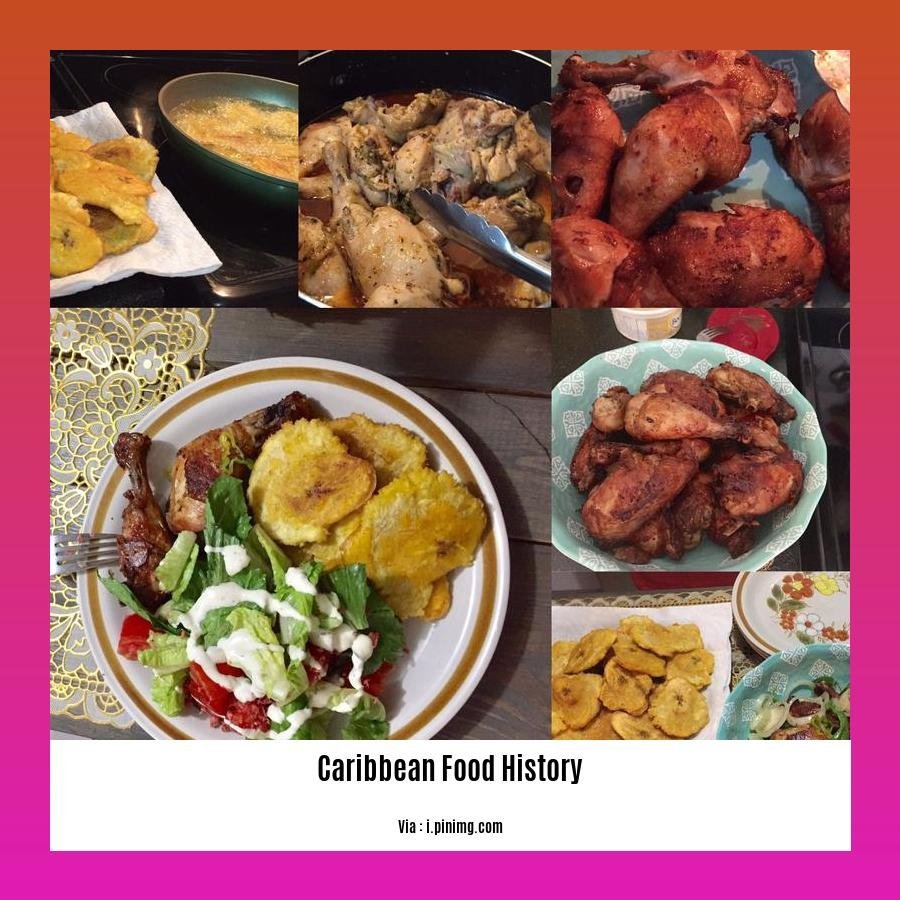
Before Christophe Colombus’ arrival, a diverse array of indigenous peoples occupied the Caribbean islands. These inhabitants cultivated a rich culinary identity, drawing on local ingredients and agricultural practices. Among the staple indigenous ingredients include:
- Cassava, also called manioc or yucca, and its derivatives, including cassava bread.
- Tubers, including yams, sweet potatoes, and arrowroot, served as vital sources of carbohydrates.
- Tropical fruits, such as pineapples, papayas, and guava, added vibrant color and flavor to their diet.
- Seafood, including fish, shellfish, and crabs, provided essential proteins.
The Amerindian influence on Caribbean cuisine is not confined to specific ingredients; it goes much further:
- Culinary techniques: The indigenous peoples employed various techniques, such as “barbequeing” over open fires and the utilization of clay ovens for baking.
- Seasoning and preservation: Indigenous people developed methods for flavoring and preserving food, including the use of indigenous herbs, spices, and seasonings like allspice and chili peppers. They also employed smoking, drying, and pickling techniques for food preservation.
- Food as medicine: Indigenous cultures placed great importance on the medicinal properties of food. They utilized herbs and spices for their healing qualities, a practice that has influenced modern Caribbean cuisine.
The Encounter of Indigenous and African Culinary Traditions
When the African diaspora arrived in the Caribbean, they brought a blend of culinary traditions and ingredients that merged with indigenous practices. This fusion gave rise to a rich tapestry of flavors and dishes that characterize Caribbean cuisine today.
Key Takeaways:
- Amerindian peoples were the first to cultivate a culinary identity in the Caribbean, utilizing local ingredients and agricultural practices.
- Cassava, yams, sweet potatoes, tropical fruits, and seafood were among the staple indigenous ingredients.
- Indigenous culinary techniques, seasoning methods, and the use of food as medicine have influenced modern Caribbean cuisine.
- The fusion of indigenous and African culinary traditions led to the development of a diverse and vibrant Caribbean cuisine.
Citation:
1.
2.
Melting Pot of Cultures: Celebrating the Fusion of Asian, Middle Eastern, and Latin American Cuisines in the Caribbean
The Caribbean, a vibrant mosaic of cultures, is a culinary melting pot where Asian, Middle Eastern, and Latin American cuisines have harmonized to create a tantalizing symphony of flavors. This fusion of culinary traditions is a testament to the region’s rich history of cultural exchange and migration.
Spice Odyssey: Asian Influence in Caribbean Cuisine
The arrival of indentured laborers from India in the 19th century brought a treasure trove of spices and culinary techniques to the Caribbean. From the fiery heat of Scotch bonnet peppers to the verdant notes of curry leaves, Asian flavors infused Caribbean cuisine with a captivating depth and complexity.
Dishes like Trinidadian curry chicken, whose aromatic blend of spices dances with tender chicken, showcase the harmonious marriage of Caribbean and Indian culinary traditions. Roti, a flatbread with roots in South Asia, has become an integral part of Caribbean street food, its soft, pliable texture the perfect complement to stews and curries.
Aromatic Delights: Middle Eastern Influence in Caribbean Cuisine
The Middle East’s culinary legacy has left an indelible mark on Caribbean cuisine. From the fragrant allure of cumin and coriander to the smoky depths of grilled meats, Middle Eastern flavors have woven their way into the region’s culinary tapestry.
Shawarma, a succulent blend of marinated meats roasted on a vertical spit, has become a beloved street food across the Caribbean. Its tender, flavorful filling, nestled in a warm pita pocket, is a testament to the enduring legacy of Middle Eastern cuisine in the region.
Latin Rhythms: Latin American Influence in Caribbean Cuisine
The Caribbean’s proximity to Latin America has fostered a vibrant exchange of culinary traditions, resulting in a rich fusion of flavors. From the vibrant heat of chili peppers to the tangy zest of citrus, Latin American influences have invigorated Caribbean cuisine with a sense of vibrancy and zest.
Dishes like mofongo, a Puerto Rican delicacy made from fried green plantains mashed with garlic, chicharrones, and broth, embody the harmonious blend of Caribbean and Latin American culinary traditions. The soft, savory mofongo, paired with stews or meats, is a culinary delight that showcases the best of both worlds.
Key Takeaways:
- The Caribbean is a culinary melting pot, with influences from Asia, the Middle East, and Latin America.
- Asian spices, brought by indentured laborers from India, have infused Caribbean cuisine with depth and complexity.
- Middle Eastern flavors, such as cumin, coriander, and grilled meats, have left an indelible mark on Caribbean cuisine.
- Latin American influences, with their vibrant heat and zest, have invigorated Caribbean cuisine with a sense of vibrancy.
- This fusion of culinary traditions has created a unique and diverse Caribbean cuisine that is celebrated worldwide.
Relevant URL Sources:
- The Caribbean Melting Pot: A Cultural and Culinary Journey
- The Caribbean Food Journey
FAQs:
Q1: What major influences have shaped Caribbean cuisine?
A1: Caribbean cuisine is a captivating blend of various cultures, including indigenous Amerindian traditions, African culinary practices brought by enslaved people, and European influences from colonizing nations like Spain, France, Britain, and the Netherlands.
Q2: What role did the indigenous peoples of the Caribbean play in shaping its cuisine?
A2: The indigenous peoples of the Caribbean, before the arrival of Europeans, developed a unique cuisine based on the ingredients available on the islands, such as cassava, sweet potatoes, and various tropical fruits. Their culinary practices and knowledge of local ingredients laid the foundation for the evolution of Caribbean cuisine.
Q3: How did the Columbian Exchange impact Caribbean food history?
A3: The Columbian Exchange, which occurred after Christopher Columbus’s arrival in the Americas, brought new ingredients from the Americas to Europe and vice versa. This exchange introduced key ingredients like tomatoes, potatoes, and chilies to the Caribbean, transforming the region’s cuisine and creating new culinary possibilities.
Q4: What culinary traditions did enslaved Africans bring to the Caribbean?
A4: Enslaved Africans brought their culinary heritage and traditions to the Caribbean, which significantly influenced the region’s cuisine. Their use of spices, such as scotch bonnet peppers and allspice, as well as techniques like smoking and stewing, became integral to Caribbean cooking, adding depth of flavor and distinctive aromas to dishes.
Q5: How has Caribbean cuisine influenced global food culture?
A5: Caribbean cuisine has made notable contributions to global food culture, particularly through the influence of Caribbean immigrants in countries like the United States and the United Kingdom. Caribbean dishes like jerk chicken, curry goat, and rice and peas have gained popularity worldwide, showcasing the vibrant flavors and culinary traditions of the Caribbean region.
- China II Review: Delicious Food & Speedy Service - April 17, 2025
- Understand Virginia’s Flag: History & Debate - April 17, 2025
- Explore Long Island’s Map: Unique Regions & Insights - April 17, 2025
